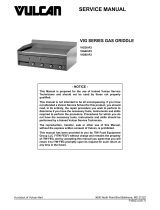
TABLE OF CONTENTS
GENERAL .................................................................................................. 3
INTRODUCTION ....................................................................................... 3
MODELS ............................................................................................... 3
INSTALLATION ........................................................................................ 3
OPERATION ........................................................................................... 3
SPECIFICATIONS ...................................................................................... 3
TOOLS ................................................................................................. 3
REMOVAL AND REPLACEMENT OF PARTS ............................................................... 5
FRONT PANEL ......................................................................................... 5
BACK PANEL .......................................................................................... 5
CONTROL DEFLECTOR (HEAT SHIELD) ............................................................... 5
TEMPERATURE CONTROLLER ........................................................................ 6
RADIANT BURNER .................................................................................... 6
THERMOCOUPLE (RADIANT BURNER) ................................................................ 7
REMOVAL ......................................................................................... 7
INSTALLATION .................................................................................... 8
PILOT (RADIANT BURNER) ............................................................................ 8
IGNITION MODULE .................................................................................... 9
GAS VALVE ............................................................................................ 9
INFRARED BURNER .................................................................................. 10
THERMOCOUPLE (INFRARED BURNER) ............................................................. 11
REMOVAL ........................................................................................ 11
INSTALLATION ................................................................................... 11
IGNITOR (INFRARED BURNER) ...................................................................... 12
PILOT ORIFICE (INFRARED BURNER) ............................................................... 12
GRIDDLE PLATE ASSEMBLY ......................................................................... 13
SERVICE PROCEDURES AND ADJUSTMENTS ........................................................... 14
TEMPERATURE CONTROLLER CALIBRATION ....................................................... 14
RADIANT BURNER - AIR SHUTTER ADJUSTMENT ................................................... 15
GAS MANIFOLD PRESSURE ADJUSTMENT .......................................................... 15
BURNER GAS ORIFICE CHECK ...................................................................... 16
THERMOCOUPLE TEST .............................................................................. 17
TEMPERATURE CONTROLLER TEST ................................................................ 17
IGNITION MODULE TEST ............................................................................. 18
RADIANT BURNER - PILOT FLAME ADJUSTMENT ................................................... 19
GAS VALVE TESTS ................................................................................... 19
INFRARED BURNER .................................................................................. 20
ADJUSTMENT .................................................................................... 20
FLAME APPEARANCE ............................................................................ 20
ELECTRICAL OPERATION ................................................................................ 21
COMPONENT FUNCTION ............................................................................ 21
SEQUENCE OF OPERATION ......................................................................... 21
GRIDDLE WIRING DIAGRAM ......................................................................... 22
TROUBLESHOOTING ..................................................................................... 23
TEMPERATURE CONTROLLER - LED DIAGNOSTICS AND OPERATING STATUS .................... 23
IGNITION MODULE - LED DIAGNOSTICS AND OPERATING STATUS ................................ 23
GENERAL ............................................................................................ 24
INFRARED BURNER .................................................................................. 26
RADIANT BURNER ................................................................................... 26
VCCG Series Heavy Duty Gas Griddle
© VULCAN 2014
F45533 (1014) Page 2 of 26





















